|
Hey TurfNet!!!
Craig DeJong, Hendersonville (NC) Country Club:
 "Dear TurfNet,
I have another nominee for 'Best Fabricated Gadget of the year!' Luke Sweeterman, our Equipment Technician, has done it again. I gave him a problem and he came up with the perfect solution!
Leaf season is here again, and it becomes very important for us to remove all the leaves and debris prior to mowing greens. During the week we walkmow our greens and the operator has a backpack blower with them in the cart. On the weekends we triplex our greens, due to staff size, and the operator does not carry a backpack blower. We needed to come up with a way for the operator to have a backpack blower handy by mounting a backpack blower to the triplex.
Luke went to work and came up with a great solution. With the help of a Sara Lee bread tray, he was able to mount a blower on the triplex while keeping it safe and giving the operator clear control of the machine."
Visit Craig's blog at hccgcgd.blogspot.com.
|
 |
|
Old Irrigation Heads...
Trey Anderson, Hickory Ridge Golf Course, Carbondale, IL:
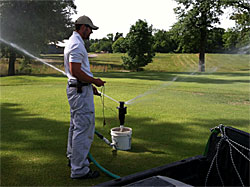
Assistant Mike Green works on testing irrigation heads.
|
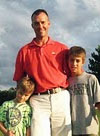 "Hickory Ridge is closing in on its 20th birthday next year. In the 19 years since the course opened its doors, we have worked on many irrigation heads. Last year we started compiling many of the small parts and inoperable heads to start condensing them with the intent on taking a bunch of bad stuff and making a smaller amount of good stuff.
Part of the process involves testing the heads with the actual pressure of the irrigation system. We came up with the bucket pictured. This 'head tester' allows us to plug into a quick coupler on the course and test irrigation heads. If they pass the test they are labeled and inventoried for use later when needed. If not, the test lets us spot the weak points and order parts if needed while discarding the bad parts."
Visit Trey's blog at hrgcturf.blogspot.com.
|
 |
|
8 White Putting Surface Modifications...
Garrett Luck, North Shore Country Club, Mequon, WI:
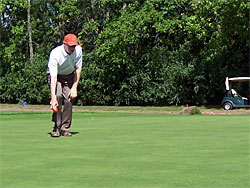
Ron Forse marking the changes.
|
 "One of the most critical yet overlooked pieces of the renovation to 8 White is the contour changes to the putting surface. Like most greens at NSCC, the putting surface on 8 White existed as a relatively flat green. While the green featured a small decline to the rear right and left, the majority of the putting surface offered little interest. In designing the plan for the eighth green, Ron Forse, golf course architect, looked to enhance the existing contours by building up and expanding the rear of the green. This new contour allows for more interesting putting, a better view from the tee, and an improved ability for the green to hold lower trajectory golf shots.
Ron Forse was on hand to oversee the changes that would ultimately occur on green. After a long conversation regarding playability and construction methods, Ron carefully painted the area which would be changed. During the process, careful measurements were taken with a digital level to guarantee that the contour would seamlessly match.
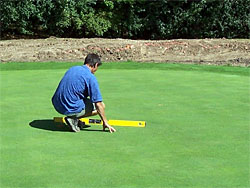
Using the digital level.
| 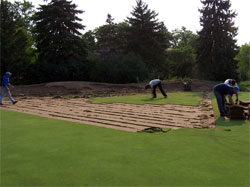
Stripping the sod.
|
Once the designated area was ready for the project all sod was removed and carefully stacked so that it could be returned to the same location. A special mix of soil was added to the exposed surface. The soil was tested to verify that it retained physical properties that very closely resemble our existing soil profile. This will eliminate the chance for turf failure at a later date due to the incompatiblity of the two soils.
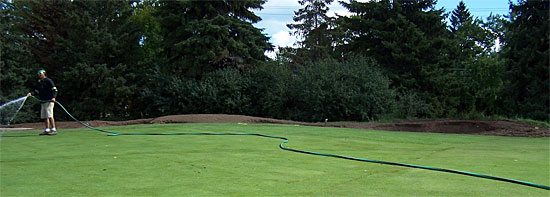
After compacting the soil mix, the sod was carefully replaced and compacted by using a vibratory plate compactor and roller. Prior to opening next May, the grounds and greens staff will continuously aerify, verticut, and roll the surface to make sure the green rolls as true as the rest of the greens at NSCC."
Visit Garrett's blog at nsccgcm.blogspot.com.
|
 |
|
Jigsaw Puzzles...
Rob Williams, Stockton Golf & Country Club, Stockton, CA:
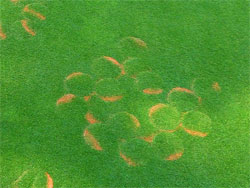
"Half-mooning" the graffiti with a cup cutter renders the words illegible.
|
 "The night before a recent ladies golfing event, which had the ladies playing with members of staff here at Stockton Golf & CC, vandals sprayed paint on three of our greens and also the restroom out on #16.
With some offensive language sprayed on the greens, and the ladies only a couple of hours away from a shot gun tee time, we scrambled a couple of groups for our crew to work on the problem greens.
"Half-mooning is when we turn the cup cutter 180° instead of removing the plug..." |
Not knowing how much, if any, grass would be lost to the graffiti we decided to take cup cutters and 'half moon' the letters. What is half mooning, you ask? Half mooning is when we sink our cup cutter to the normal depth on the green as if we were about to change a hole location, then instead of removing the cup cutter plug we actually turn the cup cutter 180 degrees and scramble the painted letters.
The orange spray paint is still visible for now but the words are illegible. As the grass grows, we will cut of the painted sections. Some areas of thick paint will not survive and we will need to plug out, then sand and seed these areas.
Areas of thick paint were plugged out and transplanted to the edges of the greens. Unfortunately we do not currently have a nursery green to deal with this type of issue. I am working on the cost to build a bent grass nursery.
These areas, though unsightly, will play the same as the rest of the green. We will need to revisit these areas over time to work on the health and appearance of the turf. In the end we are thankful that it was only paint.
Visit Rob's blog at sgccturf.blogspot.com.
|
 |
|
Lousy weather and alternative aerification...
Pat Daly, CGCS, Framingham (MA) Country Club:
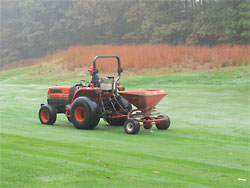
Applying our "FCC Mix".
|
 "We typically schedule our fairway aerification a year in advance. I wish I could have looked in my crystal ball and found out the weather was going to be miserable for the process. As you all know sunny and dry work the best. We try and pull a core on the fairways, drag them to break off the topsoil and use it as a topdressing, and blow them off into the rough to be mulched. It needs to be dry to have it work right.
The club received 1.3" rain from last Friday to Saturday and it was never sunny enough to dry out the course. If we tried to core aerify I can safely say it would have been a nightmare trying to clean off the fairways. Instead we tried to reschedule with multiple companies but all were backed up due to weather cancelations until November. Aerifying in November is a risky proposition since I couldn't be sure the holes would have healed in time before the winter. If they remained open, the fairways could dry out, especially if we have an open winter like last year. Instead we adjusted our program and used a solid tine. It's basically the same process except we do not pull a plug.
The first thing we do is apply our 'FCC mix'. We use a cement mixer to combine an organic fertilizer and our fairway seed blend. The fertilizer acts as a carrier for the seed and allows for us to spread it with the club's equipment.

The aerification contractor in action.
|
Next, our contractor aerifies the fairways, intermediate rough, and into the approaches (photo above). Not only does this allow air to penetrate into the crown and root zone of the plant but it also creates space for the seed.
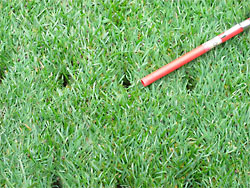
Here is the surface of the fairway with the 3/4" hole. If you look close you can see both the seed and the fertilizer on the surface.
| 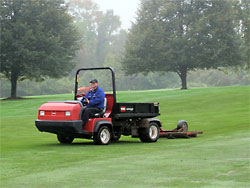
Dragging with a brush to push the seed and fertilizer into the holes.
|
Since we are not trying to break up aerification cores I decided to use a brush to push the seed and fertilizer into the holes. We followed with a blower to clean up any debris that was left on the fairway.
That is this year's fairway aerification. I'm happy that it took only a day to finish (especially since it's raining again as I write this) and I think everyone will be happy with how clean the process was. I have my staff filling in fairway divots today and hopefully we will be able to cut them tomorrow."
Visit Pat's blog at http://fccgrounds.blogspot.com
|
 |
|
Zoysia Grass Conversion...
Pat O'Brien, Hyde Park Golf & Country Club, Cincinnati, OH:
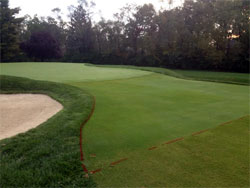
5 approach marked and ready for conversion.
|

"The staff has continued in project mode with the conversion of the bentgrass approaches to Meyer Zoysia. In a effort to improve consistency, playability and reduce costs the approaches on 1, 5 and 9 will be converted to Zoysia grass. The remaining approach areas will be converted next season."
Visit Pat's blog at hydeparkgolfandcountryclub.blogspot.com.
|
 |
|
White Pines Not Dying...
Rick Tegtmeier, CGCS, Des Moines Golf & Country Club, W. Des Moines, IA:
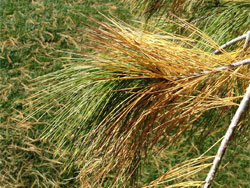
In this close up of a typical branch on a White Pine, you can see this year's growth and last year's old needles.
|
 "Pinus strobus (or White Pine, which is the common name) is a very popular Midwestern coniferous tree. We have several of them on both golf courses. This time of year I receive a lot questions about the White Pines. Many people think that they are dying or have a disease, when in fact they are going through a very natural thing for them.
Each year the White Pine puts on new growth, which means new needles. So it loses last years needles and they fall off. Right now last year's needles are very yellow and are falling all around the bases of the trees."
Visit Rick's blog at dmgcc.blogspot.com.
|
 |
|
Goats Not Union Labor...
Ken Thompson, Greate Bay Country Club, Somers Point, NJ:
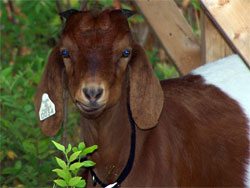
Francis contemplating her next weed to eat.
|
 "Last spring (2011) I suggested using goats to manage poison ivy and brush in the wooded and natural areas throughout the course. I thought that goats would be a better alternative than drenching these areas with herbicides that in turn could hurt the trees and other desirable plants, and maybe the birds and other wildlife that have come to live in these areas. At first the suggestion was taken lightly by the club, but in time, it began to make sense, and late last fall I was given the ok to give it a try.
Goats are not new to me. I have a small farm and years ago I adopted a dwarf Nubian goat. One goat doesn't make a herd, nor does it make me an expert, but from 'Snoops' I learned a lot about goats — their personalities, management, diet, uses, etc. Over the years, goats have become one of my favorite animals, even surpassing dogs. Fact is, some goats are smarter than dogs, and at some things, are more useful. Goats don't chase geese so much, but they have other positives, such as the ability to browse, and an independent attitude. They are also affectionate and form very tight and life lasting bonds with people and other animals, including horses.
I chose to use Boer goats for this project. Boers are a meat goat breed that originated in South Africa, and the breed is known to be very hardy in all types of climates and environments. Last fall I put a reserve on three kid does (female babies) from 'Just Kiddin Around' farm, located near Allentown, PA. Kidding season was late this spring, and I wasn't able to pick up the goats till the first week of June. Although I had reserved three, I ended up taking four, all 3 months old. That's four lucky little goats — Irene, Francis, Mary, and Lucy — that otherwise would have been fattened up and shipped off to be dinner.
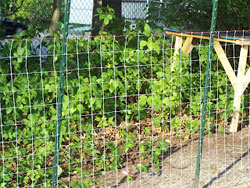
Now you see it...
| 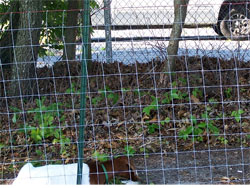
... and now you don't!
|
I had to get them used to people and to being handled. I also had to slowly take them off grain and onto hay and browse. Breeders feed them sugary grain to fatten them up and to get them to market quicker, so in a funny twist, they needed to be introduced to their natural diets.
Hard for some to believe, but goats don't eat everything... Goats don't eat tin cans or tires or cars. They are not the best grass eaters either, but prefer to browse on leaves of most deciduous plants. This includes brush, ivy, and trees.
Now, after they have been on the course for a while, I am frequently asked if the goats are 'union labor', since I give them a few days off each week. It's hard to eat poison ivy every day so I give 'em a break and put them on hay to change up and balance their diet. This keeps them from getting bored, fat, and/or under-nourished.
Back at the farm, I observe them for health reasons and we trim their hooves and do a bit of training so that they are easier to manage. While they are back at the farm, we take the opportunity to move their pen to a different area on the golf course. So it's not like they are lazy, sleeping, or having a beer while watching Jerry Springer go at it with Dr. Phil, although I have to readily admit that they are a bit more spoiled than most other goats."
Visit Ken's blog at greatebaycc.blogspot.com. (The above was excerpted from several blog posts - Editor)
|
 |
|
About our Blog Aggregator: Many superintendents are now hosting private blogs to better communicate with their golfers and/or members. Beyond local weather and course conditions, there is a great deal of information about projects, methodologies and techniques that would be of value to other superintendents — hence our Turf Blog Aggregator. As every blogger struggles occasionally with content, we also include posts intended to educate golfers about turf maintenance for others to use as a template for their own blogs.
Miss any previous issues of TBA? You can find them all here.
Turf Blog Aggregator(TM) is a trademark of Turnstile Media Group.
|
|